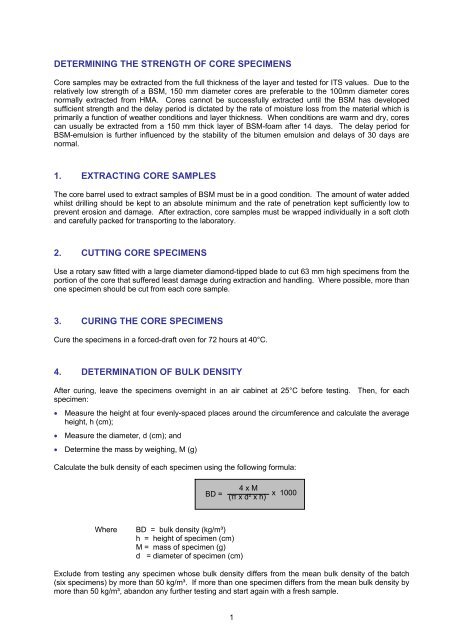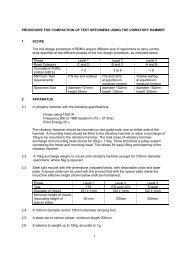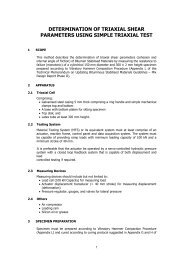Method 9. Prep of cores for testing - Asphalt Academy
Method 9. Prep of cores for testing - Asphalt Academy
Method 9. Prep of cores for testing - Asphalt Academy
- No tags were found...
You also want an ePaper? Increase the reach of your titles
YUMPU automatically turns print PDFs into web optimized ePapers that Google loves.
DETERMINING THE STRENGTH OF CORE SPECIMENS<br />
Core samples may be extracted from the full thickness <strong>of</strong> the layer and tested <strong>for</strong> ITS values. Due to the<br />
relatively low strength <strong>of</strong> a BSM, 150 mm diameter <strong>cores</strong> are preferable to the 100mm diameter <strong>cores</strong><br />
normally extracted from HMA. Cores cannot be successfully extracted until the BSM has developed<br />
sufficient strength and the delay period is dictated by the rate <strong>of</strong> moisture loss from the material which is<br />
primarily a function <strong>of</strong> weather conditions and layer thickness. When conditions are warm and dry, <strong>cores</strong><br />
can usually be extracted from a 150 mm thick layer <strong>of</strong> BSM-foam after 14 days. The delay period <strong>for</strong><br />
BSM-emulsion is further influenced by the stability <strong>of</strong> the bitumen emulsion and delays <strong>of</strong> 30 days are<br />
normal.<br />
1. EXTRACTING CORE SAMPLES<br />
The core barrel used to extract samples <strong>of</strong> BSM must be in a good condition. The amount <strong>of</strong> water added<br />
whilst drilling should be kept to an absolute minimum and the rate <strong>of</strong> penetration kept sufficiently low to<br />
prevent erosion and damage. After extraction, core samples must be wrapped individually in a s<strong>of</strong>t cloth<br />
and carefully packed <strong>for</strong> transporting to the laboratory.<br />
2. CUTTING CORE SPECIMENS<br />
Use a rotary saw fitted with a large diameter diamond-tipped blade to cut 63 mm high specimens from the<br />
portion <strong>of</strong> the core that suffered least damage during extraction and handling. Where possible, more than<br />
one specimen should be cut from each core sample.<br />
3. CURING THE CORE SPECIMENS<br />
Cure the specimens in a <strong>for</strong>ced-draft oven <strong>for</strong> 72 hours at 40°C.<br />
4. DETERMINATION OF BULK DENSITY<br />
After curing, leave the specimens overnight in an air cabinet at 25°C be<strong>for</strong>e <strong>testing</strong>. Then, <strong>for</strong> each<br />
specimen:<br />
• Measure the height at four evenly-spaced places around the circumference and calculate the average<br />
height, h (cm);<br />
• Measure the diameter, d (cm); and<br />
• Determine the mass by weighing, M (g)<br />
Calculate the bulk density <strong>of</strong> each specimen using the following <strong>for</strong>mula:<br />
BD =<br />
4 x M<br />
(π x d² x h)<br />
x 1000<br />
Where<br />
BD = bulk density (kg/m³)<br />
h = height <strong>of</strong> specimen (cm)<br />
M = mass <strong>of</strong> specimen (g)<br />
d = diameter <strong>of</strong> specimen (cm)<br />
Exclude from <strong>testing</strong> any specimen whose bulk density differs from the mean bulk density <strong>of</strong> the batch<br />
(six specimens) by more than 50 kg/m³. If more than one specimen differs from the mean bulk density by<br />
more than 50 kg/m³, abandon any further <strong>testing</strong> and start again with a fresh sample.<br />
1
5. DETERMINATION OF THE INDIRECT TENSILE STRENGTH (ITS)<br />
Follow the procedures described under Section D4.6 above <strong>for</strong> <strong>testing</strong> the core specimens to determine<br />
the ITS DRY and ITS SOAKED values and the resulting TSR value. These values are then used to determine<br />
whether the material has met the minimum specified requirements.<br />
Note. Where the ITS results <strong>for</strong> specimens are in conflict with those obtained from core specimens, the<br />
results <strong>for</strong> the core specimens should be taken as being the correct values.<br />
2












